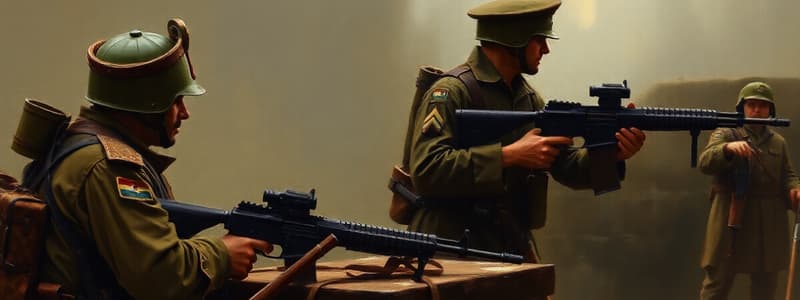Podcast
Questions and Answers
Which of the following is an example of a threat identified within the intelligence category?
Which of the following is an example of a threat identified within the intelligence category?
- Capture of significant numbers of enemy prisoners of war
- Increased unemployment within the population (correct)
- Identification of an information requirement
- Modification of an airspace coordinating measure
Which of these options is a factor related to 'Movement and Maneuver' that can impact operations?
Which of these options is a factor related to 'Movement and Maneuver' that can impact operations?
- Numbers of dislocated civilians sufficient to affect friendly operations (correct)
- Interference with freedom of religious worship
- Effective enemy counterfire
- Destruction of any place of worship by friendly fire
Which of these options is an example of a factor that can impact decision making during execution?
Which of these options is an example of a factor that can impact decision making during execution?
- Receipt of an air tasking order
- Enemy electronic attack use
- Establishment of unplanned obstacles along major routes (correct)
- Unplanned repositioning of firing units
Identify the factor that falls under the intelligence category and directly relates to identifying potential threats.
Identify the factor that falls under the intelligence category and directly relates to identifying potential threats.
What is the primary purpose of validating and refining a new course of action (COA)?
What is the primary purpose of validating and refining a new course of action (COA)?
Identify the factor that impacts 'Movement and Maneuver' in terms of hindering friendly forces' movements.
Identify the factor that impacts 'Movement and Maneuver' in terms of hindering friendly forces' movements.
Which of these options is considered a 'Fires' factor that could disrupt the fire support plan during execution?
Which of these options is considered a 'Fires' factor that could disrupt the fire support plan during execution?
Which of these is NOT a part of the validation and refinement process of a new COA?
Which of these is NOT a part of the validation and refinement process of a new COA?
What is the main goal of the mental war game conducted during COA validation and refinement?
What is the main goal of the mental war game conducted during COA validation and refinement?
Which of these options is a key indicator of how well a unit is achieving its objectives in the 'Movement and Maneuver' category?
Which of these options is a key indicator of how well a unit is achieving its objectives in the 'Movement and Maneuver' category?
Which of these options is NOT a factor that influences decision-making during execution?
Which of these options is NOT a factor that influences decision-making during execution?
What are essential elements of friendly information (EEFIs)?
What are essential elements of friendly information (EEFIs)?
Which of the following is an example of an information requirement that could be nominated as a CCIR?
Which of the following is an example of an information requirement that could be nominated as a CCIR?
What is the role of the future operations cell during COA validation and refinement?
What is the role of the future operations cell during COA validation and refinement?
Who is responsible for directing a hasty operations synchronization meeting?
Who is responsible for directing a hasty operations synchronization meeting?
What is the primary focus of the COA validation and refinement process?
What is the primary focus of the COA validation and refinement process?
Which of the following is NOT a common revision to products needed to affect adjustments?
Which of the following is NOT a common revision to products needed to affect adjustments?
What is the purpose of a FRAGORD in the context of adjustments?
What is the purpose of a FRAGORD in the context of adjustments?
Who is responsible for informing the commander of any changes made to the COA?
Who is responsible for informing the commander of any changes made to the COA?
In which scenarios does the commander issue orders to subordinates verbally?
In which scenarios does the commander issue orders to subordinates verbally?
How is the staff notified of a pending change in the COA?
How is the staff notified of a pending change in the COA?
If a COA does not adequately solve the problem initially, who takes action to modify or create a new one?
If a COA does not adequately solve the problem initially, who takes action to modify or create a new one?
What is the primary purpose of the validation and refinement process in COA development?
What is the primary purpose of the validation and refinement process in COA development?
What aspect of the COA is typically adjusted in an adjustment decision?
What aspect of the COA is typically adjusted in an adjustment decision?
What is the main purpose of identifying variances during operations?
What is the main purpose of identifying variances during operations?
What is the difference between an opportunity and a threat in the context of variances?
What is the difference between an opportunity and a threat in the context of variances?
What is an execution decision?
What is an execution decision?
When is an adjustment decision necessary?
When is an adjustment decision necessary?
What is meant by "reframing the problem" in the context of variances?
What is meant by "reframing the problem" in the context of variances?
What is the significance of decision points in relation to execution decisions?
What is the significance of decision points in relation to execution decisions?
What should a commander do if the variance is so extreme that the current plan lacks the flexibility to respond?
What should a commander do if the variance is so extreme that the current plan lacks the flexibility to respond?
What is the main advantage of identifying variances during operations?
What is the main advantage of identifying variances during operations?
What is the main purpose of the Rapid Decision-Making and Synchronization Process (RDSP)?
What is the main purpose of the Rapid Decision-Making and Synchronization Process (RDSP)?
Which of the following is NOT a consideration when using the RDSP?
Which of the following is NOT a consideration when using the RDSP?
What is the relationship between the RDSP and the commander's intent?
What is the relationship between the RDSP and the commander's intent?
How does the RDSP differ from the MDMP?
How does the RDSP differ from the MDMP?
Which of the following is NOT a benefit of using the RDSP?
Which of the following is NOT a benefit of using the RDSP?
How does the RDSP promote situational understanding?
How does the RDSP promote situational understanding?
What is the primary purpose of the RDSP, as described in the content?
What is the primary purpose of the RDSP, as described in the content?
What is the primary goal of conducting a confirmation brief or backbrief during task verification?
What is the primary goal of conducting a confirmation brief or backbrief during task verification?
What is the purpose of updating decision support templates and synchronization matrices after the completion of the analysis phase?
What is the purpose of updating decision support templates and synchronization matrices after the completion of the analysis phase?
What is the primary role of the current operations integration cell during the implementation of the RDSP (Refined Decision Support Package)?
What is the primary role of the current operations integration cell during the implementation of the RDSP (Refined Decision Support Package)?
Which of the following is NOT an outcome considered when making synchronization decisions during execution?
Which of the following is NOT an outcome considered when making synchronization decisions during execution?
How does cross talk among subordinate commanders contribute to successful execution?
How does cross talk among subordinate commanders contribute to successful execution?
What is the primary purpose of collaboration among higher, adjacent, supporting, and subordinate commanders during execution?
What is the primary purpose of collaboration among higher, adjacent, supporting, and subordinate commanders during execution?
What is the main objective of synchronizing actions to eliminate undesired effects?
What is the main objective of synchronizing actions to eliminate undesired effects?
How does anticipating certain outcomes during execution contribute to successful operations?
How does anticipating certain outcomes during execution contribute to successful operations?
Flashcards
Variance
Variance
A difference between the actual situation and the planned forecast during operations.
Opportunity (in Variance)
Opportunity (in Variance)
A favorable variance that allows for more effective mission accomplishment.
Threat (in Variance)
Threat (in Variance)
An unfavorable variance that hinders mission success or force survival.
Adjusting Orders
Adjusting Orders
Signup and view all the flashcards
Execution Decision
Execution Decision
Signup and view all the flashcards
Decision Point
Decision Point
Signup and view all the flashcards
Reframing the Problem
Reframing the Problem
Signup and view all the flashcards
Assessment Plan
Assessment Plan
Signup and view all the flashcards
Unanticipated Situation
Unanticipated Situation
Signup and view all the flashcards
Fragmentary Orders
Fragmentary Orders
Signup and view all the flashcards
Rapid Decision-Making and Synchronization Process (RDSP)
Rapid Decision-Making and Synchronization Process (RDSP)
Signup and view all the flashcards
MDMP
MDMP
Signup and view all the flashcards
Situational Understanding
Situational Understanding
Signup and view all the flashcards
Combining Experience and Intuition
Combining Experience and Intuition
Signup and view all the flashcards
Acceptable COAs
Acceptable COAs
Signup and view all the flashcards
Rapid Analysis
Rapid Analysis
Signup and view all the flashcards
Identification of threats
Identification of threats
Signup and view all the flashcards
High-value targets
High-value targets
Signup and view all the flashcards
Enemy electronic attack
Enemy electronic attack
Signup and view all the flashcards
Unplanned obstacles
Unplanned obstacles
Signup and view all the flashcards
Civilian displacement
Civilian displacement
Signup and view all the flashcards
Battle damage assessment
Battle damage assessment
Signup and view all the flashcards
Friendly fire
Friendly fire
Signup and view all the flashcards
Modification of coordination measures
Modification of coordination measures
Signup and view all the flashcards
Medical Evacuation Prioritization
Medical Evacuation Prioritization
Signup and view all the flashcards
Repositioning Logistics Assets
Repositioning Logistics Assets
Signup and view all the flashcards
Adjusting Measures
Adjusting Measures
Signup and view all the flashcards
Validation of COA
Validation of COA
Signup and view all the flashcards
Mental War Gaming
Mental War Gaming
Signup and view all the flashcards
CCIR Nomination
CCIR Nomination
Signup and view all the flashcards
FRAGORD Development
FRAGORD Development
Signup and view all the flashcards
Warfighting Function Impact
Warfighting Function Impact
Signup and view all the flashcards
Verification Methods
Verification Methods
Signup and view all the flashcards
Synchronization
Synchronization
Signup and view all the flashcards
Current Operations Integration Cell
Current Operations Integration Cell
Signup and view all the flashcards
Combat Power Massing
Combat Power Massing
Signup and view all the flashcards
Combined Arms Integration
Combined Arms Integration
Signup and view all the flashcards
Cross Talk
Cross Talk
Signup and view all the flashcards
Higher Echelon Commander Role
Higher Echelon Commander Role
Signup and view all the flashcards
Decision Support Templates
Decision Support Templates
Signup and view all the flashcards
Changes in Objectives
Changes in Objectives
Signup and view all the flashcards
Potential Enemy Reactions
Potential Enemy Reactions
Signup and view all the flashcards
Friendly Counteractions
Friendly Counteractions
Signup and view all the flashcards
CCIRs
CCIRs
Signup and view all the flashcards
Implementation of COA
Implementation of COA
Signup and view all the flashcards
FRAGORD
FRAGORD
Signup and view all the flashcards
WARNORDs
WARNORDs
Signup and view all the flashcards
Updated Information Collection Plan
Updated Information Collection Plan
Signup and view all the flashcards
Study Notes
Decision Making During Execution
- Execution is putting a plan into action using combat power to achieve the mission and adjust operations in response to situation changes.
- Commanders, staffs, and subordinate commanders focus on translating decisions into actions.
- Execution involves deciding whether to execute planned actions, changing phases, or executing branch plans while adjusting the plan based on situation changes and operational progress.
- Assessment is crucial in execution
- Assessment monitoring current operations and evaluating progress and variances.
- Decision making involves decisions to exploit opportunities or counter threats.
- Directing action involves applying combat power and resources at decisive points and times.
- Continuous assessment is essential to change plans, take advantage of opportunities, or react to threats.
- Monitoring involves observing conditions relevant to operations.
- Evaluating uses indicators to judge progress and identify variances.
Assessment During Execution
- Assessment helps visualize probable outcomes and determine if a plan needs adjustments.
- Monitoring is the continuous observation of relevant conditions.
- Evaluating uses indicators to judge progress and identifies variances and their significance.
- Variance is a difference between the actual situation and the planned one.
Rapid Decision-Making and Synchronization Process (RDSP)
- The RDSP is a technique using rapid analysis instead of detailed analysis.
- The RDSP seeks a timely and effective solution within the commander's intent.
- The RDSP involves combining experience and intuition to quickly reach situational understanding.
- The RDSP integrates all warfighting functions.
- The RDSP enables quick adjustments to the order or mission.
- The RDSP is continuous, allowing commanders to react immediately to opportunities and threats.
- The RDSP is based on the existing order and the commander's priorities.
Decision Making During Operations
- When operations progress favorably, variances are minor.
- Commanders allow operations to continue according to plan.
- Execution decisions implement planned actions under anticipated circumstances.
- If operations don't progress according to expectations, an adjustment decision is made.
- An adjustment decision changes the order to address unanticipated threats or opportunities.
- Staffs ensure operations remain synchronized when adjustments are made.
- Adjustment decisions may involve reframing the problem to develop a new plan.
Directing Action
- Commanders direct actions to reapply resources and combat power, often synchronizing operations.
- The staff resynchronizes operations to maximize combat power application, including factors of time, space, and purpose.
- Staff issues directives to subordinate commanders.
Studying That Suits You
Use AI to generate personalized quizzes and flashcards to suit your learning preferences.




